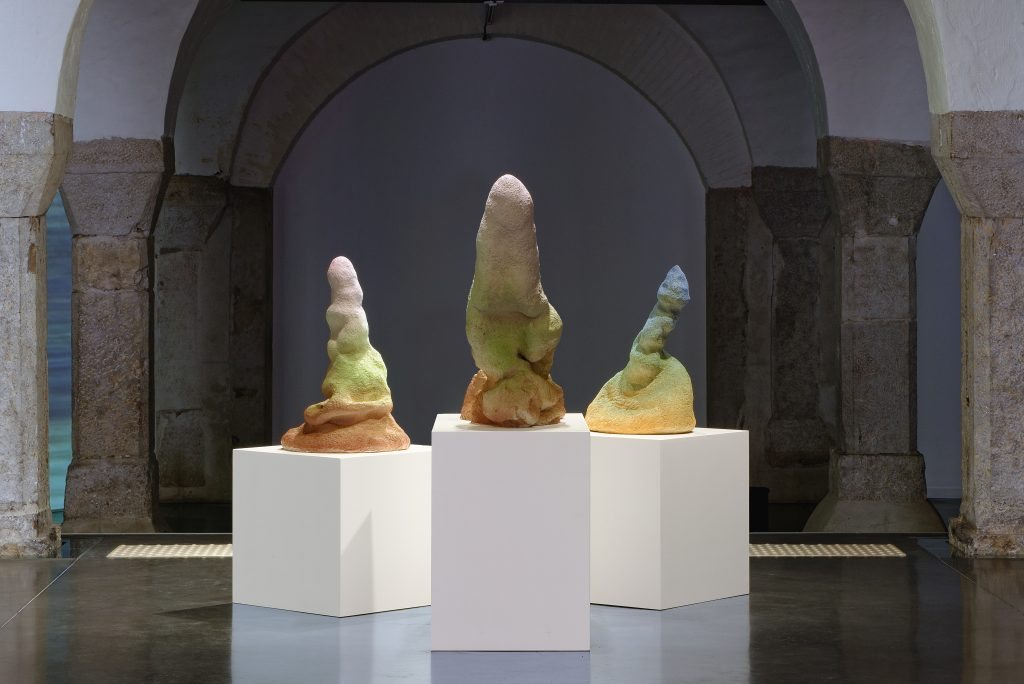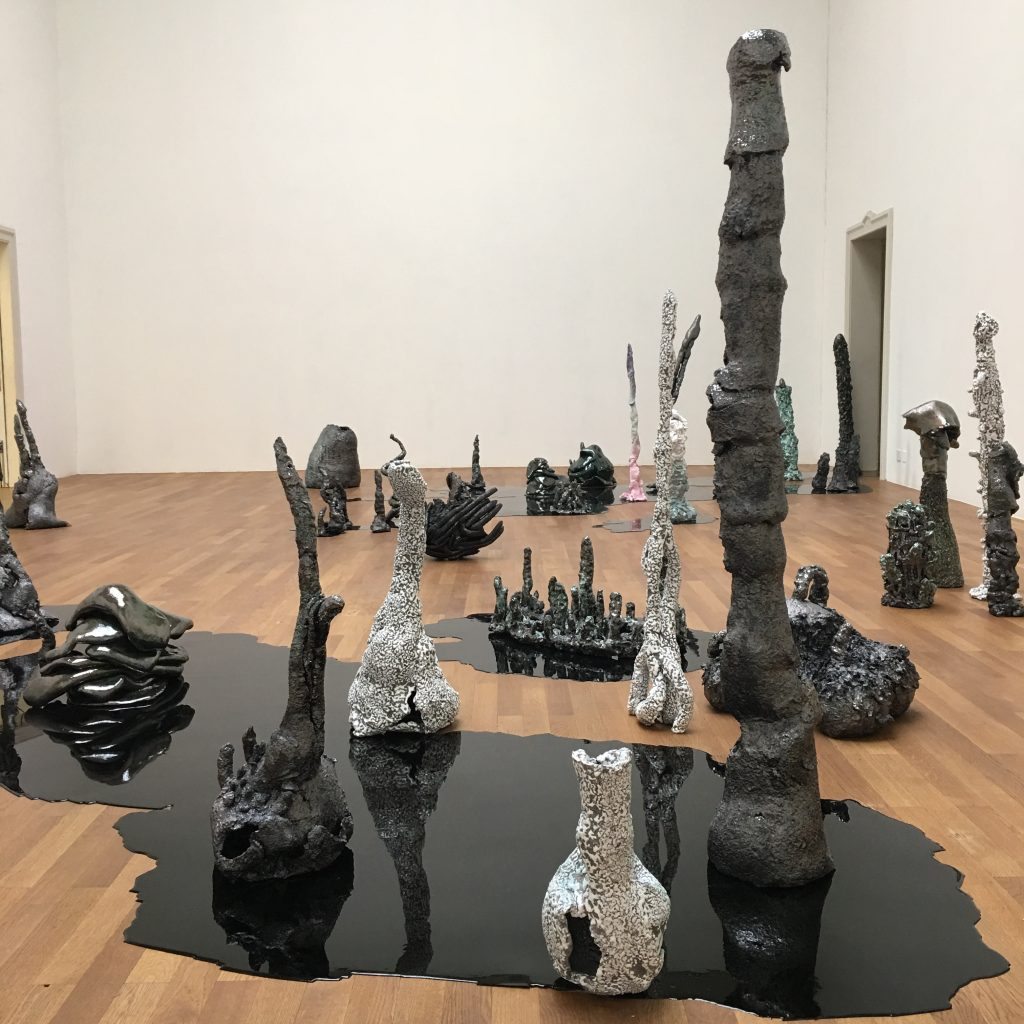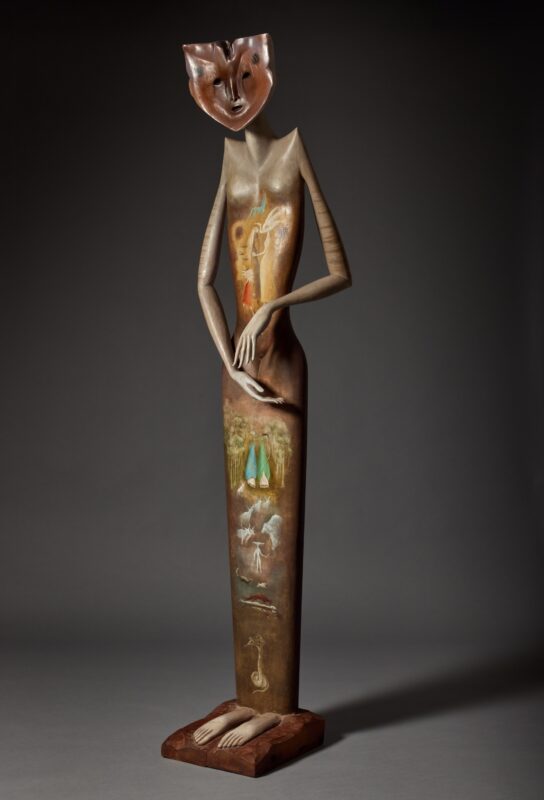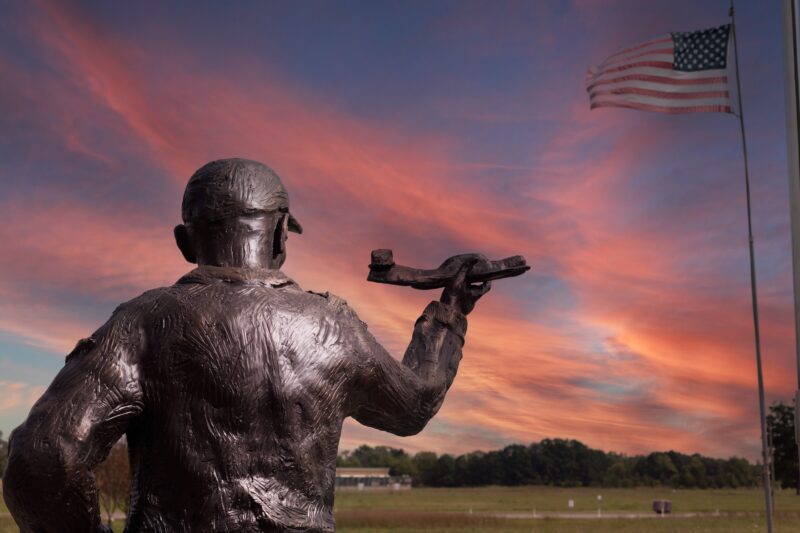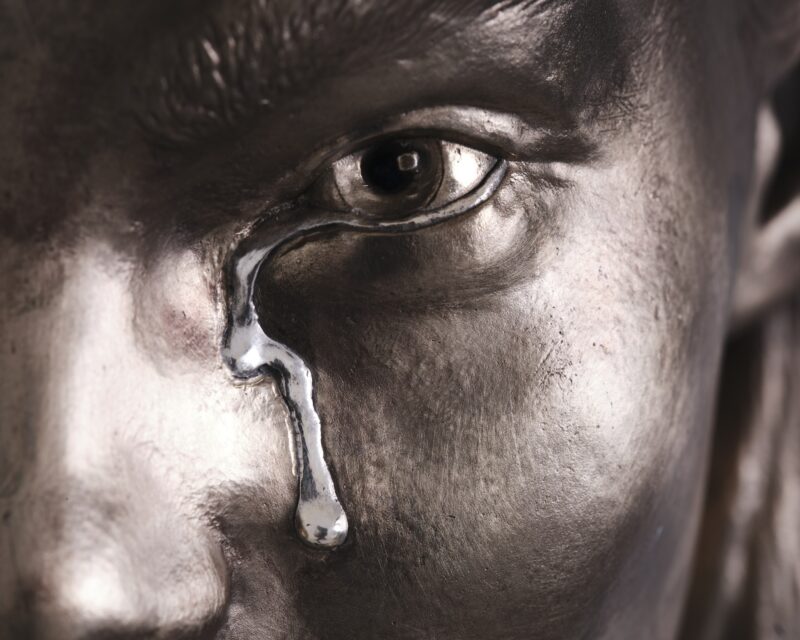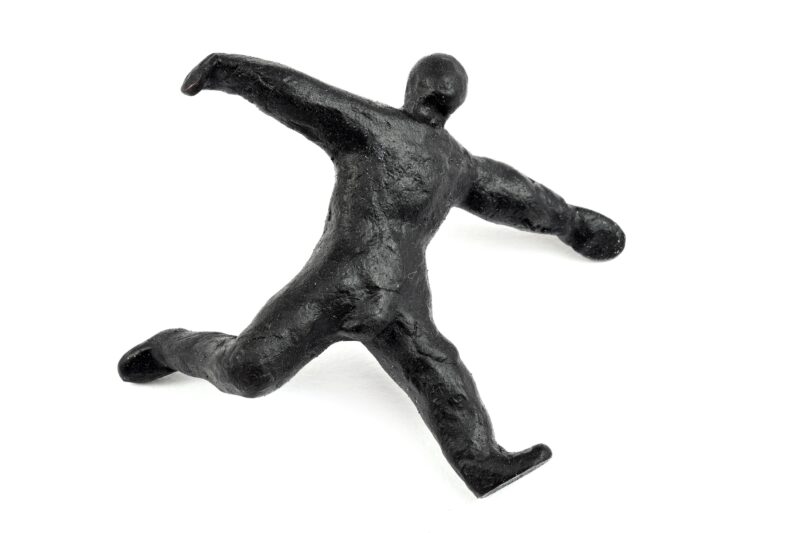
London-based Italian artist Salvatore Arancio presents a ground-breaking new outdoor ceramic sculptural installation at this year’s Venice Biennale curated by Christine Macel (on until 26th November 2017). Situated in the Giardino delle Vergini, at the end of what Macel calls the “Pavilion of Time and Infinity”, Arancio’s contribution to the 57th Venice Biennale takes the form of a sort of therapeutic sculpture garden, where visitors are confronted by these mysterious, primeval totemic formations inspired by the petrified trees that were formed in Hawaii when a lava flow swept through a forest in 1790. Arancio works across a range of media such as ceramic sculpture, collage, etching, animation and video. Inspired by nature, science, psychedelia and popular mythology, his practice is driven by curiosity and the potential of images. Departing from their literal meaning or original function, Arancio makes artworks that blur the liminal space between fantasy and reality, leaving the viewer with a growing sense of unease and ambiguity. In addition to this new installation in Venice, Arancio’s work will be the subject of a new solo exhibition titled And These Crystals Are Just Like Globes of Light at Federica Schiavo Gallery in Milan (19 May – 15 July 2017).
Congratulations on your inclusion in Viva Arte Viva, the curated section of the 2017 Venice Biennale! Please tell me a little bit more about your new sculptural installation in Venice. I understand that it takes its inspiration from an earlier performance commissioned by the Whitechapel Gallery relating to hypnotherapy.
Thanks Marcelle! Yes, you are right, the new pieces take as a starting point a performance originally commissioned by the Whitechapel Gallery in 2015 entitled: “MIND AND BODY BODY AND MIND”. The performance, which coexists as a video that I am also presenting at this year’s Venice Biennale, was a live re-enactment of a hypnotherapy session that I found on the Internet. Its goal was to turn the listener into a better artist.
The idea that a hypnotherapy session could enhance somebody’s artistic skills immediately struck me as a rather humorous, tongue-in-cheek interpretation of what it means to be an artist and the function of art education, but also potentially a great and simple way to improve the world. I decided then to use the original script and to create a live re-enactment of the session, extrapolating the text and having an actor recite it against the background of very psychedelic, trance-inducing footage and sound. For this footage, I used images overlapped with continuous flashes of lights, the frequency of which is identical to the one reproduced by the Dream Machine created by Brion Gysin, William S. Burroughs and Ian Sommerville in the late 50s, together with binaural beats, which are meant to stimulate Alpha brainwave levels. These brainwaves are connected with higher levels of creativity that typically are found in artists, musicians and creative thinkers, whilst the flashing lights of the Dream Machine are meant to induce a hypnagogic state.
So going back to the sculpture installation in Venice entitled It Was Only a Matter of Time Before We Found the Pyramid and Forced It Open, the pieces were produced under the influence of this hypnotherapy session and the results of this artistic enhancement, directly putting in practice its effects. Following the slightly tongue-in-cheek tone of the video, I see the space as a sort of therapeutic “healing area”, where visitors are confronted by enigmatic primordial or possibly science fictional totemic formations, whilst being able to absorb this artistic enhancing aura before leaving the Biennale.
The sculptural pieces are shaped by forms informed by the petrified trees of the Lava Trees State Park on Hawaii Island. This park preserves lava moulds of the tree trunks that were formed when a lava flow swept through a forested area in 1790.

How do you feel your work responds to Macel’s overall curatorial theme for Viva Arte Viva, an exhibition focusing on art and artists via a story told in nine chapters ending in the Pavilion of Time and Infinity where your work sits? I find the following statement by Macel especially poignant of your practice: “Art is the realm for dreams and utopias, a catalyst for human connections that roots us both to nature and the cosmos, that elevates us to a spiritual dimension.”
Christine mentions my work in the press release, whist talking about ideas and questions related to our relationship with time: ‘In face of the lagoon, the artist disappears or reinvents himself as “improved”, through the power of hypnosis.’ I suppose questions about time and the lapse of it in my work are always present; it is a time that is never defined, always having a diffused, temporal presence. As a viewer, you are always faced with that question, confronted with a present that could be a beginning or an end or even an obsolete future that is now almost nostalgic.
I also agree with your reading of the works; it is definitely something I suggest and especially with the pieces presented at this year’s Venice Biennale. Their strong relationship to nature is evident through the use of a natural material like clay manipulated in order to become nature again, but in this case nature has become fetishised as in the lava trees’ totemic presence. Also, by glazing the resulting shapes with impenetrable iridescent colours and giving this sculptural installation the title It Was Only a Matter of Time Before We Found the Pyramid and Forced It Open, I make a direct connection to my continuous obsession with the monolith in Stanley Kubrick’s 2001: A Space Odyssey. I like the idea that the unwary “worshippers” are confronted with these sentinels, the idea that their gaze is somehow reciprocated but these impenetrable totems, spouting out of a magmatic matter coming from a distant future or past, have found a home in the Biennale’s ground staring at the unwary art crowd…
As with the rest of my works, these new pieces are connected to my ongoing fascination with nature as a theatre for rituals, worship and self-induced trance states, employed to make a connection with something above us.
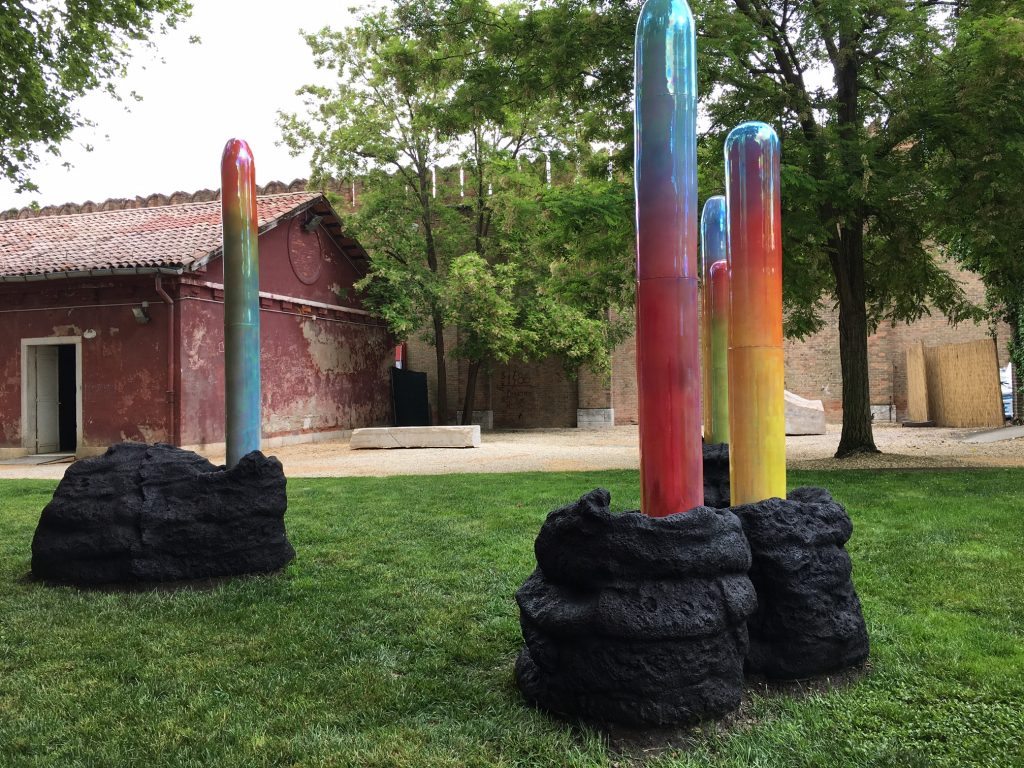
You created these new materially stunning sculptures at the highly respected Ceramica Gatti, founded in Faenza in 1928, joining a coterie of art and design world stars who have created their own ceramic masterpieces there (including Ilya and Emilia Kabakov, Marc Camille Chaimowicz and Ettore Sottsass among others). Placing large glazed ceramic sculptures outdoors is a very brave proposition given the conservation issues and risk of cracking. What was this production process like?
Well to begin with, I decided that I did not want to sit down and show something I had already done; instead, I treated this invitation to the Biennale as a reason to push further my practice and to take some chances. Probably a bit crazy, but I felt it was the right attitude.
Ceramica Gatti has been a place of excellence since 1928 and they are in some ways unique… It was very special to be working in such an amazing place full of history! To start with, I suppose there would not be so many places that would have agreed to collaborate on such an adventurous project, especially with such a short production window. Imagine that we started these monumental pieces at the beginning of January…. And if you consider the nature of the material, drying times and possible failures, it has been complete lunacy! Among all of this frantic work, we had to consider their positioning outdoors for several months and several changes of weather, so we had to research some new protective materials, some of them so new in the market and advanced that these new works almost felt like they were arriving from the future. The research part of the work also took a lot of our energies. But deep down, I quite like the idea that some changes might occur; it somehow makes sense working with a material that originally comes from nature itself.
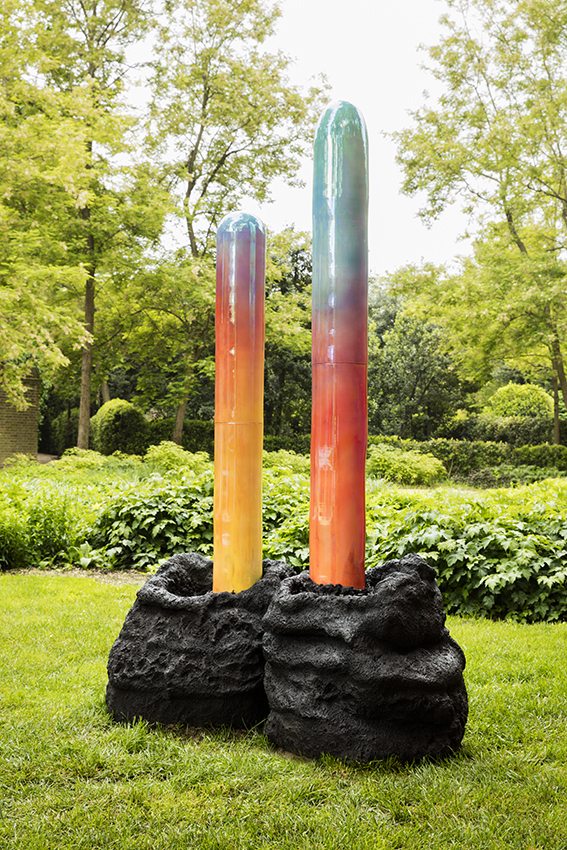
Your work is very much inspired by forms found in nature and science but why the obsession with the totem or phallic form? What does this shape or symbol represent to you?
I suppose it pertains to the presence of phallic forms in nature, but this shape, in several cultures, religions and mythology, often expresses connections to spiritual realms. I see it as a shape that in itself symbolizes a peak… an ascension to something above us.
In your artist video for the Venice Biennale, you state that you like to think about your work “functioning like the pages of an Atlas of confusion, a kind of hallucinated, meaningful nonsense.” Is the viewer’s emotional response to your work important to the success of each artwork you create?
Oh totally! I always aim to create a relation with the viewer to somehow create an experience for them. This is why my exhibitions always use a myriad of different mediums. I would like my works to engage with the viewer in different layers, initially through seduction and then slowly to entice the viewer into a territory that somehow might become unfamiliar or difficult to comprehend, whilst playing with symbols and meanings.
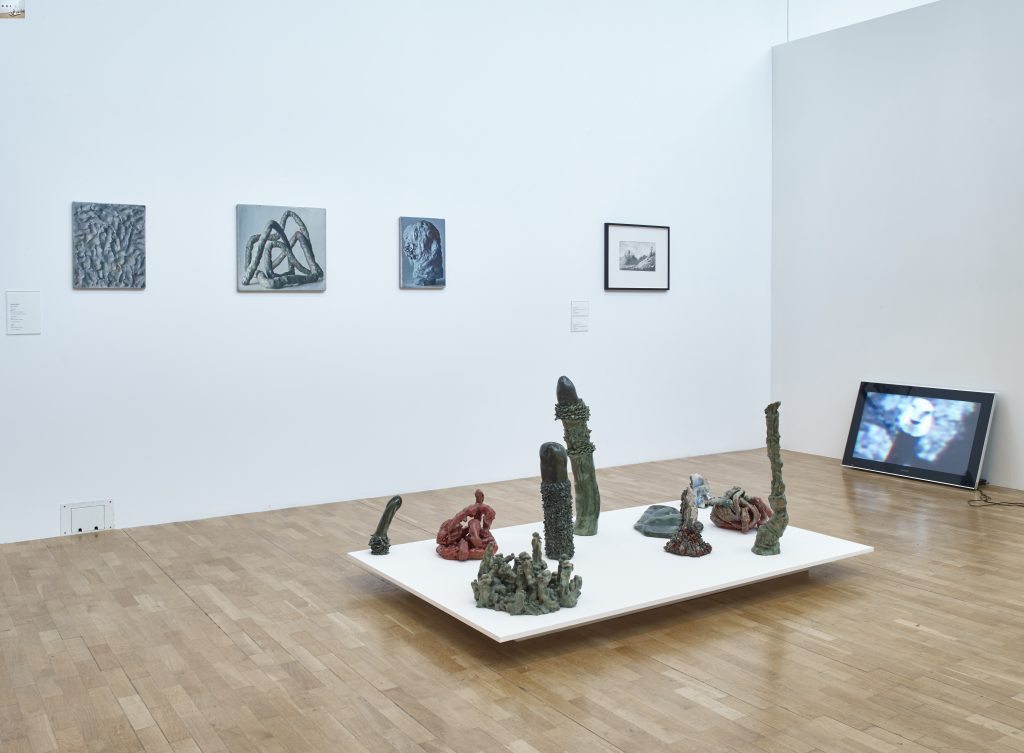
How important is the staging of your ceramic installations? You have created a myriad of different modes of display for your ceramic sculptures – traditional plinths of different shapes and sizes, floor-based displays and purpose-built tables, each of them responding to their architectural surroundings and producing a different texture and atmosphere to the exhibition.
I suppose I like to be playful with traditional modes of display. I somehow enjoy subverting them but also using them as a device in order to create or add to possible narratives, which the sculptures might suggest initially. I also like to be challenged by the architecture of where my work is displayed and to play with it. I remember once I had to explain to a curator, how excited I was about the space he proposed as he kept apologizing because it was far from a white cube… who needs a white cube!
Links
Viva Arte Viva, 57th Venice Biennale, Venice (13th May – 26th November 2017): http://www.labiennale.org/en/art/exhibition/macel/index.html
Artist video for 57th Venice Biennale: https://www.youtube.com/watch?v=oWNnxoZ8g6c
Artist’s website: http://www.salvatorearancio.com/index.html
Federica Schiavo Gallery, Milan: http://www.federicaschiavo.com/Artists/Salvatore-Arancio
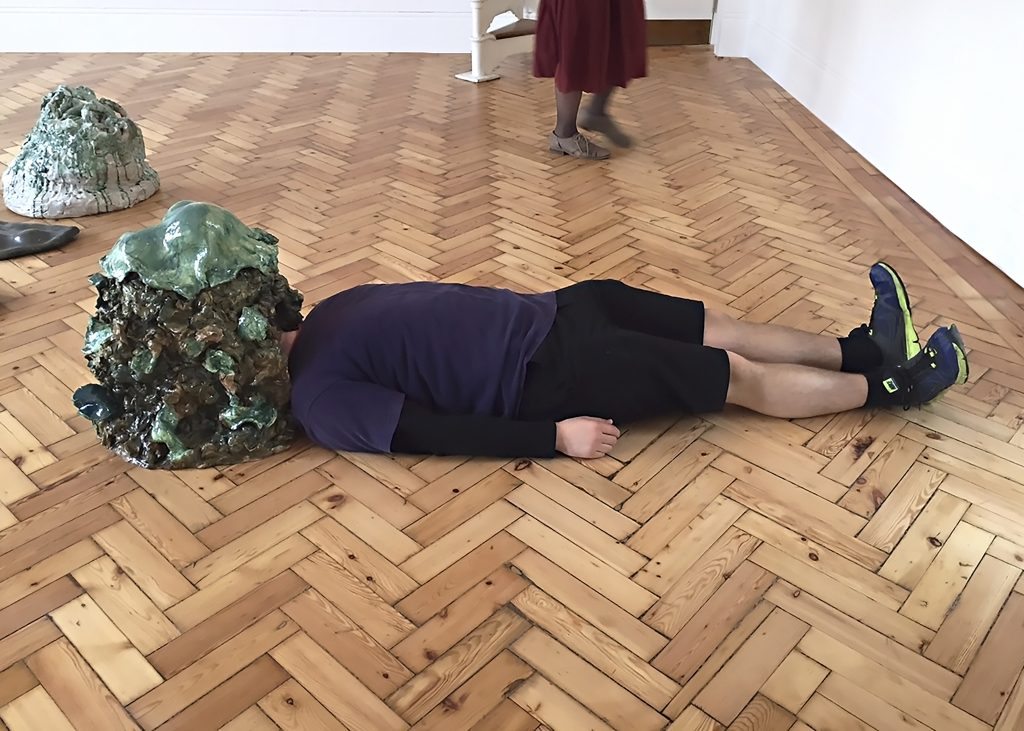
Captions
All images courtesy of the artist and Federica Schiavo Gallery, Milan unless otherwise stated
Images 1, 3 and 4: Salvatore Arancio, It Was Only a Matter of Time Before We Found the Pyramid and Forced It Open, 2017, glazed and unglazed ceramic, epoxy resin, 160 x 90 x 270 cm, Photo: Andrea Rossetti.
Image 2: Salvatore Arancio, MIND AND BODY BODY AND MIND, 2015, video still, looped video with sound, 16 min 37 sec.
Image 5: Salvatore Arancio, (from left) Ai-Laau; Pele; Pii, 2013, glazed ceramic, installation view at Centre d’Art Contemporain La Halle des Bouchers, Vienne, France.
Image 6: Salvatore Arancio, installation view at The London Open exhibition, Whitechapel Gallery, 2015. Courtesy of Whitechapel Gallery, Whitechapel Gallery Archive, the artist and Federica Schiavo Gallery. Photo: Stephen White
Image 7: Salvatore Arancio, And These Crystals Are Just Like Globes of Light, glazed ceramic, dimensions variable, installation view at Kunsthalle Winterthur, Switzerland.
Image 8: Salvatore Arancio, Fashioned to a Device behind a Tree, 2015, glazed ceramic, dimensions variable, installation view of performance at Camden Arts Center, London.
About the Artist
Salvatore Arancio (b.1974, Catania, Italy) lives and works in London. He received his MA in Photography from the Royal College of Art, London in 2005. Selected exhibitions include: Synthetic Landscape, Weston Park, Ludlow, UK (2017); And These Crystals Are Just like Globes of Light, Federica Schiavo Gallery, Milano, Italy (2017); In the EarthTime. Our generations of Italian ceramics and the Faenza Prize, Gyeonggi International Ceramic Biennale, Icheon, Korea (2017); Viva Arte Viva, 57th International Art Exhibition, La Biennale di Venezia, Venice, Italy (2017); Tropical Hangover, Tenderpixel, London, UK (2017); Evolutionary Travels, Foundación Arte, Buenos Aires, Argentina (2016); Travelling Circular Labyrinths, Museo Civico di Castelbuono, Castelbuono, Palermo, Italy (2016); Oh Mexico! Kunsthalle Winterthur, Winterthur, Switzerland (2016); Fashioned to a Device Behind a Tree, Camden Arts Centre, London, UK (2015); Drawing Biennial, Drawing Room, London (2015); Cathedral, AV Festival, NGCA, Sunderland, UK (2013); PROJECT, Maureen Paley Gallery, London, UK, (2013); Curiosity: Art & the Pleasure of Knowing, Hayward Touring UK (2013); Alternating Layers of Contrasting Resistance, Rowing, London, UK (2013), Solo Presentation, Art Rotterdam, Rotterdam, The Netherlands (2013), The Little Man of the Forest With the Big Hat, Federica Schiavo Gallery, Rome, Italy (2013); Cyclorama, Museo Tamayo Arte Contemporáneo, Mexico City, Mexico (2013); Relatively Absolute, Wysing Arts Centre, Cambridge; The Little Man of the Forest With the Big Hat, MCZ-Museo Carlo Zauli, Faenza, Italy (2012); An Arrangement of the Materials Ejected, Spacex, Exeter (2011); To See an Object to See a Light, Fondazione Sandretto Re Rebaudengo, Guarene d’Alba, Italy, (2011);Vedere un oggetto, vedere la luce, Fondazione Sandretto Re Rebaudengo, Guarene d’Alba, Italy (2011); Sentinel -PPS//Meetings#4, Palazzo Riso – Museo d’Arte Contemporanea della Sicilia, Palermo, Italy (2011); SI-Sindrome Italiana, Le MagasinCentre National d’Art contemporain de Grenoble, France (2010); Catastrophe? Quelle Catastrophe!, Manif d’Art 5, The Quebec City Biennial, Engramme, Quebec City, Canada (2010); Prague Biennale 4, Karlin Hall, Prague, Czech Republic, (2009); and I giovani che visitano le nostre rovine non vi vedono che uno stile, GAM-Galleria d’Arte Moderna, Turin, Italy (2009). Selected residencies include: Camden Arts Centre, Ceramics Fellowship, London, UK, 2014/15; Résidences Internationales aux Recollets, Paris, France, 2013; European Ceramic WorkCentre, SG ‘s-Hertogenbosch, The Netherlands; Wysing Arts Center, Cambridge, UK; ISCP, New York, 2009; Art Omi, New York, 2011. Arancio is represented by Federica Schiavo Gallery, Milan, Italy.
